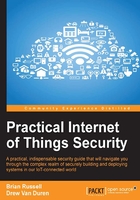
Chapter 1. A Brave New World
"When the winds of change blow, some people build walls and others build windmills."
--— Chinese proverb
The Internet of Things is changing everything. Unfortunately, many industries, consumer and commercial technology device owners, and infrastructure operators are fast discovering themselves at the precipice of a security nightmare. The drive to make all devices "smart" is creating a frenzy of opportunity for cyber-criminals, nation-state actors, and security researchers alike. These threats will only grow in their potential impact on the economy, corporations, business transactions, individual privacy, and safety. Target, Sony Pictures, insurance providers such as Blue Cross, and even the White House Office of Personnel and Management (OPM) provide vivid, not-so-pleasant newsflashes about major vulnerabilities and security breaches in the traditional cybersecurity sense. Some of these breaches have led to the tarnishing or downfall of companies and CEOs, and most importantly, significant damage to individual citizens. Our record in cybersecurity has proven to be substandard. Now consider the world of the Internet of Things, or IoT, things such as Linux-embedded smart refrigerators, connected washing machines, automobiles, wearables, implantable medical devices, factory robotics systems, and just about anything newly connected over networks. Historically, many of these industries never had to be concerned with security. Given the feverish race to be competitive with marketable new products and features, however, they now find themselves in dangerous territory, not knowing how to develop, deploy, and securely operate.
While we advance technologically, there are ever-present human motivations and tendencies in some people to attempt, consciously or unconsciously, to exploit those advancements. We asserted above that we are at the precipice of a security nightmare. What do we mean by this? For one, technology innovation in the IoT is rapidly outpacing the security knowledge and awareness of the IoT. New physical and information systems, devices, and connections barely dreamed of a decade ago are quickly stretching human ethics to the limit. Consider a similar field that allows us to draw analogies—bioethics and the new, extraordinary genetic engineering capabilities we now have. We can now biologically synthesize DNA from digitally sequenced nucleotide bases to engineer new attributes into creatures, and humans. Just because we can do something doesn't mean we always should. Just because we can connect a new device doesn't mean we always should. But that is exactly what the IoT is doing.
We must counterbalance all of our dreamy, hopeful thoughts about humanity's future with the fact that human consciousness and behavior always has, and always will, fall short of utopian ideals. There will always be overt and concealed criminal activity; there will always be otherwise decent citizens who find themselves entangled in plots, financial messes, blackmail; there will always be accidents; there will always be profiteers and scammers willing to hurt and benefit from the misery of others. In short, there will always be some individuals motivated to break in and compromise devices and systems for the same reason a burglar breaks into your house to steal your most prized possessions. Your loss is his gain. Worse, with the IoT, the motivation may extend to imposing physical injury or even death in some cases. A keystroke today can save a human life if properly configuring a pacemaker; it can also disable a car's braking system or hobble an Iranian nuclear research facility.
IoT security is clearly important, but before we can delve into practical aspects of securing it, the remainder of this chapter will address the following:
- Defining the IoT
- IoT uses today
- The cybersecurity, cyber-physical, and IoT relationship
- Why cross-industry collaboration is vital
- The things in the IoT
- Enterprise IoT
- The IoT of the future and the need to secure it